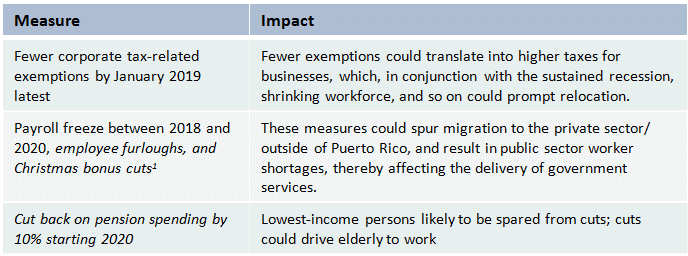Puerto Rico’s recent filing for bankruptcy protection was a result of its public debt accrual of nearly $74 billion in bond debts and $49 billion in pension liabilities. At a time when the island is already grappling with issues of negative GDP growth, high unemployment, and widespread poverty, the impending debt restructuring process and anticipated fiscal consolidation measures will only strengthen downward pressures on the economy.
The section below examines some of the key causative factors behind the accrual of these massive debts in detail.
- US’s Repeal of Section 936: Under this section, starting 1976, income generated from the US subsidiaries in Puerto Rico (a US territory) was exempt from US corporate income taxes. In addition, Puerto Rico also extended tax-related incentives to US subsidiaries. The complete repeal of Section 936 in 1996 prompted the relocation of US factories and resulted in lowered tax revenues and GDP growth.
- Overspending of Government: Puerto Rico has long been spending more than it generates in revenues, unlike US states that are required to come up with balanced budget plans. The Puerto Rican government has long been resorting to bonds to finance its expenditure, even daily operations, due to which bond debts have risen from more than $43 billion in 2006 to nearly $74 billion currently.
- Large-scale Migration: The US citizenship of Puerto Ricans is a key driver of migration. The ongoing recession and high unemployment rates have only led to the intensification of migration. Migration has contributed to a shrinking working age population and a lower tax base.
To move towards greater fiscal sustainability, the government recently drew up a detailed fiscal plan that was approved by a federal oversight board, subject to amendments. The exhibit below examines some of the proposed fiscal consolidation measures and associated implications in detail.
Exhibit 1: Impact Analysis of Some Key Fiscal Consolidation Measures

Note: Measures in standard font—Proposed as part of the government’s fiscal plan
Measures in italics—Amendments proposed by the federal oversight board
Puerto Rico’s dire domestic economic and fiscal conditions are expected to spur greater migration to the US and other countries. As a result, the proportion of its working age population is likely to continue to decline. Intensified migration, along with an expected decline in investments and cancellation of infrastructure projects will weigh in on Puerto Rico’s already weak growth. GDP growth is expected to contract from an estimated (1.8%) in 2016 to (3%) in 2017, with the island expected to remain in recession for the next few years.
Exhibit 2: GDP Growth, Puerto Rico, 2010–2020
In effect, Puerto Rico’s already weak economy is expected to come under greater strain over the next few years because of the ongoing debt crisis. The Puerto Rican government will have to shoulder the responsibility of improving its fiscal balance and restoring investor confidence over time in order to boost the island’s growth and development prospects.
[1] Implementation of furloughs and bonus cuts can be avoided if the government shores up cash reserves to $200 million by July 1, 2017.



